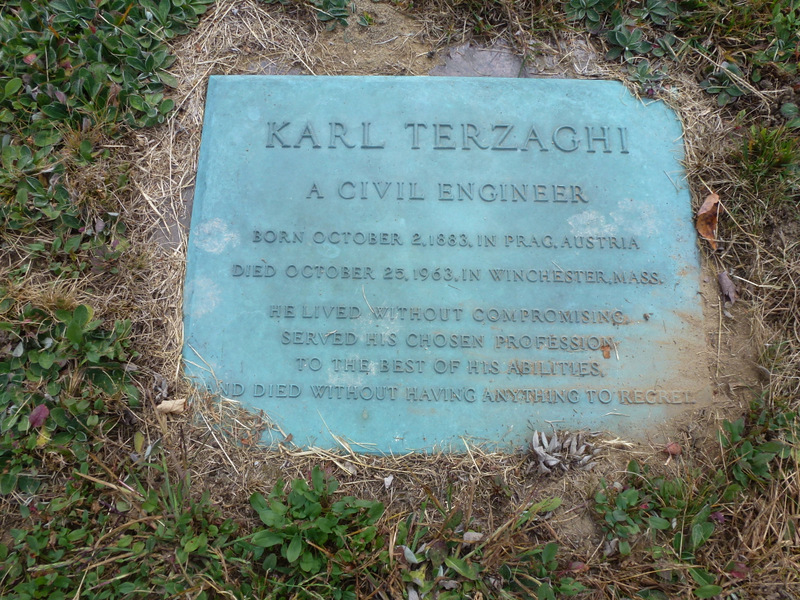türkçe links to original article by Prof. Dr. Ural Akbulut
(Milliyet Newspaper)
//Ed. Note: Last week's collapse of a building in
Istanbul highlighted the irony of Karl von Terzaghi
having established the basic science of solid building
construction while teaching in Turkey just about 100
years ago.//
collapse click here for the story of a recent building
collapse in Istanbul's Kartal district.
Karl von Terzaghi
Early Life
Karl von Terzaghi was the founder of the science of modern soil
mechanics and he developed the related theoretical and experimental
measurement methods in Turkey. Terzaghi (1883-1963) grew up in
Austria, excelled in geometry, mathematics and astronomy, and
graduated from Graz Technical University in 1900 as a mechanical
engineer.
After service in the military, Terzaghi took university classes in
geology, roads and railroads. But it was while he was working for a
company in Vienna that he was affected by the collapse of a dam
caused by soil and the settlement of an apartment building during its
construction. At this company, Terzaghi prepared reinforced concrete
projects and solved ground problems. He worked on a dam project in
Croatia and eliminated a collapse problem for buildings surrounding a
construction project in Russia.
Terzaghi's doctoral thesis was "Calculating Foundations for Circular
Tanks", which he completed in 1912. That same year he went to the
USA to view dam constructions and worked as a driller when he
could not find other work. Returning to Austria, Terzaghi served
again in the military in 1914 during World War I, participating in
fighting as a first lieutenant on the Serbian border.
Life in Turkey
In accordance with an agreement between the Austro-Hungarian
Empire and the Ottoman State, Terzaghi went to Istanbul in 1916
to work as a professor. His mentor at the Yüksek Mühendis Mektebi
(Istanbul Technical University) was Professor Dr. Philipp
Forchheimer, who had arranged for Terzaghi's invitation to Turkey.
At the university, Terzaghi taught "Usul-ü Umumiye-i İnşaat" (Basic
Principles of Construction), related to general construction engineering
and soil mechanics.
It was the first time anywhere in the world that "soil mechanics" had
been taught and it happened in Turkey. But Terzaghi lacked the proper
tools and a budget to conduct proper scientific research on soil
mechanics. Nevertheless, he was able to measure lateral soil pressures
that affected retaining walls and the results were published in a journal
in the USA. The calculations Terzaghi made with a steel meter and
boxes were later borne out with sophisticated modern instruments.
Terzaghi made soil calculations for a trans-Bosphorus bridge and
tunnel project but when the English occupied Istanbul in 1918,
he was fired. Terzaghi found work teaching at Robert College (later
Boğaziçi University) in Istanbul and in 1919 he measured the
permiability of clay samples he collected from various areas,
discovering the empty water relationship between clay, sand and rock.
This discovery helped in determining the reasons for dam collapses
and in the adoption of counter-measures.
Terzaghi's "Consolidation Theory" was the first theory of soil
mechanics and related to the mathematical methods he developed
for determining the number of buildings a particular place could
support, based on the laws of physics. Terzaghi's work was
published in the book "Erdbaumechanik" in 1924 and he earned the
title "Father of Modern Soil Mechanics".
Post-Turkey Life
Terzaghi's fame prompted America's Massachusetts Institute of
Technology (MIT) to lure him away from Istanbul in 1925. His
findings were published in an American engineering journal in
1925 and in 1926 he wrote a book. But problems with the MIT
administration led Terzaghi back to Vienna Technical University
in 1929.

He subsequently met Adolph Hitler and served as an advisor to
Hitler for new building projects. Terzaghi visited Russia again
and began to feel antipathy toward Communism. When accused
of being a Nazi, he said "people in my homeland say I'm a Nazi
and the Nazis say I'm a Bolshevik. The Bolsheviks say that I'm
a conservative idealist."
Terzaghi served as chairman for the "Soil Mechanics Congress"
at Harvard in 1936 and he became the president of the International
Soil Mechanics Association. Despite his notoriety, though, he was
unable to find work in America because of the Great Depression.
Returning to Vienna, Terzaghi became embroiled in a constroversy
with a university colleague named Paul Fillunger, who claimed
that Terzaghi's discoveries were baseless. Ultimately, Terzaghi
emerged the winner in the debate and Fillunger committed suicide.
Terzaghi went to Harvard in 1938, becoming a U.S. citizen in
1943 and retiring from Harvard in 1953. He served as the chairman
of the advisory council for the Aswan Dam in Egypt and passed
away in 1963. Terzaghi helped to ensure that tall buildings and
bridges would be built solidly. He told everyone that Turkey was
his second homeland.


Hiç yorum yok:
Yorum Gönder